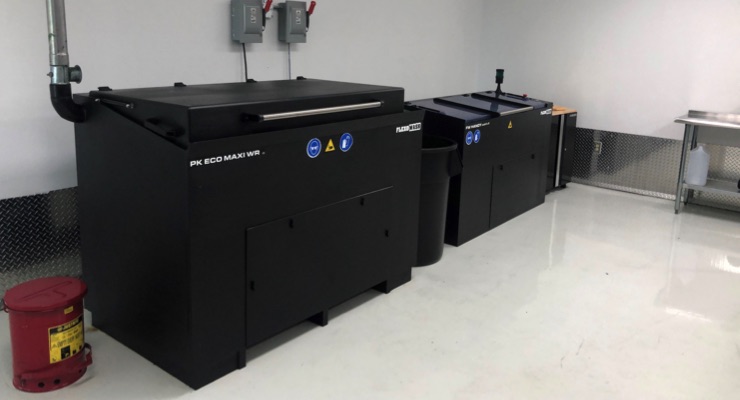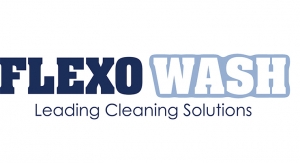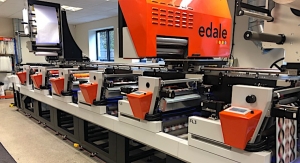L&NW Staff08.06.20
Mark Cook, founder and CEO of Catapult Print, has created a customer-driven business that has invested heavily in the latest and greatest technologies. Rather than using just the human eye to compare color and cross-check continuity, Catapult’s modern systems ensure consistency and quality with every job.
At Catapult, everything is driven by technology, meaning that every label to come off press will be the same as the approved proof, whether it's the first print run or the 50th.
When Mark Cook started Catapult Print in April of 2018, he took a different, more modern approach to the company. He invested in the most modern Nilpeter presses and kitted out the production site in order to produce the best labels possible.
Catapult operates 24/7 to fulfill demand and ensure it is always delivering for the customer. This growing converter recently installed its fourth Nilpeter press in the span of two years, with the capacity to house 10 full-time presses.
With increases in business and production, it is vital that all processes are as efficient and streamlined as possible. Cook recognized that the lost time incurred by poor anilox and parts cleaning was a pressure-point toward the company's “zero down-time” objective.
Harder-to-clean inks
Some of the ink used in high-quality printing, such as metallics, can prove difficult to clean off the anilox using traditional methods alone. The former anilox cleaner that Catapult used was causing some tension toward its tight production goals, which in turn slowed down the efficiencies driven by Catapult's advanced make-ready procedure.
Catapult prides itself on treating every job as the work of art that it is. “Illustrations and graphic design that are true works of art add an enormous level of intricacy to the printing. As these designs grow more popular, the technological advancements that make this possible are quickly becoming indispensable to today’s printing industry," states Cook.
According to Chris Mountain, factory manager at Catapult Print, “We have strict tolerances for color matching. We match all of our inks to Pantone digital library and our target is under Delta E 2. With the old anilox cleaner since they were not cleaned properly, we were noticing weaker colors and spitting issues. This was causing at least a few hours of downtime a week as we always take the time to make things right before the job is printed.”
Pain points
The cleaning portion of the production chain was the weak link, with too much time being spent trying to clean aniloxes that never really were getting clean. Their previous cleaner would only allow for one anilox to be cleaned at a time. Not only was this time consuming for the team, it was also inefficient.
Mountain adds, “We were not happy with the previous cleaner due to the various issues. We had contact with Keith Young at Flexo Wash, and he suggested we trial the machine for a week. When he came to install the machine for trial, we decided to put it to the test with our dirtiest anilox, which was badly stained and the old machine could not get clean. After about 20 minutes in the Flexo Wash anilox cleaner, it came out like brand new, and we knew we would need to purchase one right then.”
Catapult purchased the FW Handy 2x2 anilox cleaner. This anilox cleaner allows for four aniloxes to be cleaned in a single cycle, removing all unnecessary down-time and producing like-new parts after every wash.
Parts need cleaning too
In addition to the troubles with anilox cleaning, there were other parts that required dedicated maintenance, as well. Catapult had a specific employee responsible for cleaning chambers and other press parts throughout the day.
Catapult decided to purchase the PK Eco Maxi WR parts washer after seeing the positive results from the Flexo Wash anilox cleaner.
By the numbers: Before Flexo Wash
Cook recognizes the importance of minimal downtime in the printing process, and a weak cleaning system was contributing to that downtime. By modernizing the “housekeeping” elements of the process, keeping both aniloxes and parts clean and on a cleaning schedule, the results have been excellent, he notes. Consistent high-quality color, even production and little-to-no downtime have been the benefits of the Flexo Wash cleaning systems.
“To others considering investing in a Flexo Wash cleaning system, I would fully recommend and ‘go for it,’" says Mountain.."This has been one of the best decisions we’ve made regarding machinery, and we are very happy with the investment.”
To read an in-depth profile on Catapult Print, click here.
At Catapult, everything is driven by technology, meaning that every label to come off press will be the same as the approved proof, whether it's the first print run or the 50th.
When Mark Cook started Catapult Print in April of 2018, he took a different, more modern approach to the company. He invested in the most modern Nilpeter presses and kitted out the production site in order to produce the best labels possible.
Catapult operates 24/7 to fulfill demand and ensure it is always delivering for the customer. This growing converter recently installed its fourth Nilpeter press in the span of two years, with the capacity to house 10 full-time presses.
With increases in business and production, it is vital that all processes are as efficient and streamlined as possible. Cook recognized that the lost time incurred by poor anilox and parts cleaning was a pressure-point toward the company's “zero down-time” objective.
Harder-to-clean inks
Some of the ink used in high-quality printing, such as metallics, can prove difficult to clean off the anilox using traditional methods alone. The former anilox cleaner that Catapult used was causing some tension toward its tight production goals, which in turn slowed down the efficiencies driven by Catapult's advanced make-ready procedure.
Catapult prides itself on treating every job as the work of art that it is. “Illustrations and graphic design that are true works of art add an enormous level of intricacy to the printing. As these designs grow more popular, the technological advancements that make this possible are quickly becoming indispensable to today’s printing industry," states Cook.
According to Chris Mountain, factory manager at Catapult Print, “We have strict tolerances for color matching. We match all of our inks to Pantone digital library and our target is under Delta E 2. With the old anilox cleaner since they were not cleaned properly, we were noticing weaker colors and spitting issues. This was causing at least a few hours of downtime a week as we always take the time to make things right before the job is printed.”
Pain points
The cleaning portion of the production chain was the weak link, with too much time being spent trying to clean aniloxes that never really were getting clean. Their previous cleaner would only allow for one anilox to be cleaned at a time. Not only was this time consuming for the team, it was also inefficient.
Mountain adds, “We were not happy with the previous cleaner due to the various issues. We had contact with Keith Young at Flexo Wash, and he suggested we trial the machine for a week. When he came to install the machine for trial, we decided to put it to the test with our dirtiest anilox, which was badly stained and the old machine could not get clean. After about 20 minutes in the Flexo Wash anilox cleaner, it came out like brand new, and we knew we would need to purchase one right then.”
Catapult purchased the FW Handy 2x2 anilox cleaner. This anilox cleaner allows for four aniloxes to be cleaned in a single cycle, removing all unnecessary down-time and producing like-new parts after every wash.
Parts need cleaning too
In addition to the troubles with anilox cleaning, there were other parts that required dedicated maintenance, as well. Catapult had a specific employee responsible for cleaning chambers and other press parts throughout the day.
Catapult decided to purchase the PK Eco Maxi WR parts washer after seeing the positive results from the Flexo Wash anilox cleaner.
By the numbers: Before Flexo Wash
- Catapult cleaned 1-5 anilox rolls per day, sometimes running the same anilox for hours as it wouldn’t be clean enough.
- Catapult spent $13,000 a year on cleaning solutions.
- The former anilox cleaner could only clean one anilox at a time.
- To clean an anilox roll, it would have to be run many times through the cleaner as it was not clean enough on the first pass.
- Catapult had a few hours of downtime a week dealing with dirty anilox rolls.
- Parts were cleaned manually by hand by one dedicated employee.
- Cleaning parts would consume an entire shift.
- Catapult cleans 10-20 rolls per day.
- Catapult spends $6,000 a year on cleaning supplies.
- Flexo Wash anilox cleaner cleans four rolls at the same time and they are totally clean after one cycle.
- Most anilox rolls are cleaned once a week.
- Anilox rolls that are used for metallics, adhesives and/or whites are washed after each use.
- Flexo Wash machines have completely eliminated weak colors and spitting issues with the ink. Ink downtime is down to nearly zero hours a week due to how well the aniloxes are cleaned.
- The dedicated parts washer employee is being utilized in other departments. Time spent cleaning the chambers has been significantly reduced to 2/3 of the original time.
Cook recognizes the importance of minimal downtime in the printing process, and a weak cleaning system was contributing to that downtime. By modernizing the “housekeeping” elements of the process, keeping both aniloxes and parts clean and on a cleaning schedule, the results have been excellent, he notes. Consistent high-quality color, even production and little-to-no downtime have been the benefits of the Flexo Wash cleaning systems.
“To others considering investing in a Flexo Wash cleaning system, I would fully recommend and ‘go for it,’" says Mountain.."This has been one of the best decisions we’ve made regarding machinery, and we are very happy with the investment.”
To read an in-depth profile on Catapult Print, click here.
















